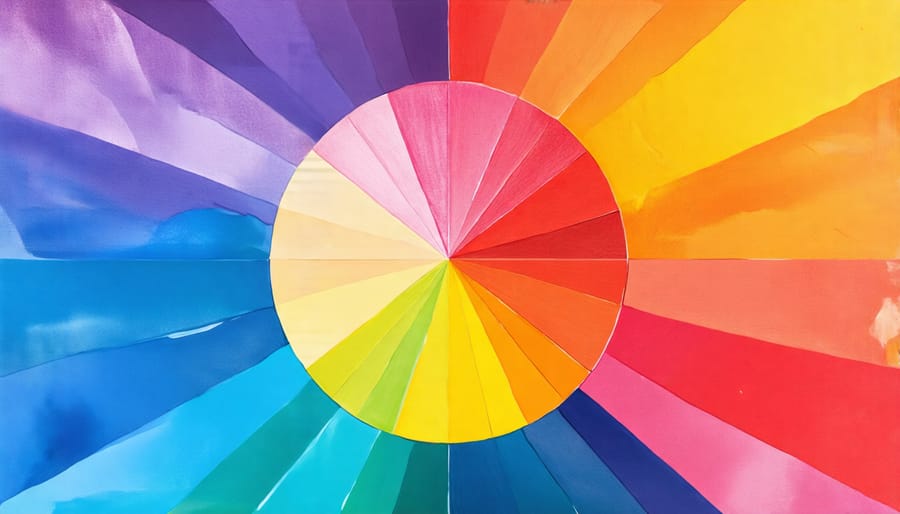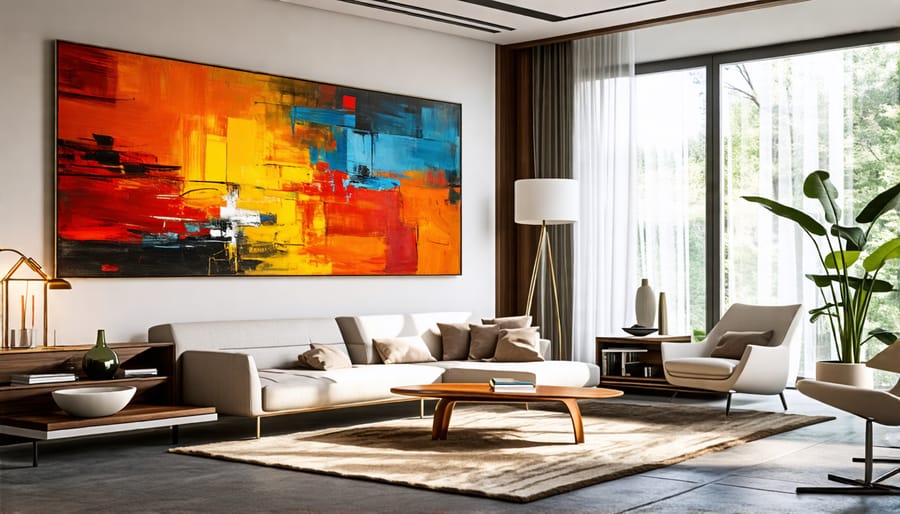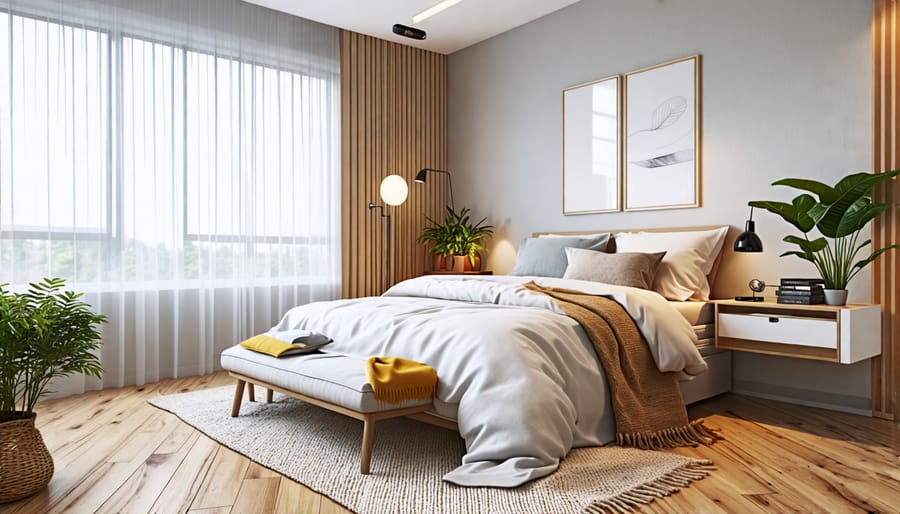Harness the power of color psychology, balance, focal points, and scale to craft interior spaces that are visually stunning, highly functional, and deeply resonant. Understand how color influences mood and perception – cool tones calm and soothe while warm hues energize and stimulate. Create harmony and balance by distributing visual weight evenly, playing with symmetry and asymmetry. Establish captivating focal points that draw the eye and anchor the space, whether a striking work of art, unique furniture piece, or architectural feature. Employ scale thoughtfully, ensuring furnishings and decor elements are proportionate to the room’s dimensions for a cohesive, intentional aesthetic. By mindfully applying these foundational interior design theories, transform any space into an expressive reflection of your unique style and a haven perfectly suited to your lifestyle needs.
Color Theory
Color Wheel Basics
The color wheel is a fundamental tool in interior design, showcasing the relationships between primary, secondary, and tertiary colors. Red, blue, and yellow are the primary colors, which cannot be created by mixing other hues. Combining two primary colors results in secondary colors: green, orange, and purple. Tertiary colors, such as blue-green or red-orange, are formed by mixing a primary and an adjacent secondary color. Understanding the color wheel helps designers create harmonious color schemes, whether using complementary colors opposite each other on the wheel, analogous colors adjacent to one another, or monochromatic variations of a single hue. By mastering color wheel basics, you can confidently experiment with color in your interior design projects.

Color Schemes
When it comes to crafting a visually appealing interior, understanding color schemes is key. Monochromatic color schemes use varying shades and tints of a single hue, creating a cohesive and calming atmosphere perfect for bedrooms or spa-like bathrooms. Complementary schemes, on the other hand, pair opposite colors on the wheel for a bold, dynamic look that works well in living rooms or home offices.
Analogous schemes use adjacent colors, such as blue, green, and teal, for a harmonious feel suited to kitchens or family rooms. Triadic schemes employ three evenly-spaced colors on the wheel, like red, yellow, and blue, for a vibrant, playful vibe ideal for kids’ rooms or creative spaces.
When selecting a color scheme, consider the room’s purpose, the desired mood, and existing elements like furniture or artwork. Don’t be afraid to experiment with swatches or try out colors in different lighting conditions before committing. With a little color know-how, you can transform any room into a beautifully designed haven that reflects your unique style.
Focal Point Theory
In interior design, creating a focal point in each room is essential for drawing the eye and anchoring the space. A focal point serves as the center of attention, providing a visual anchor that helps tie the room together and creates a sense of purpose and harmony. To establish a focal point, consider the room’s natural features, such as a fireplace, large window, or architectural detail, and highlight them through strategic placement of furniture, artwork, and décor.
When selecting a focal point, choose an element that reflects your personal style and complements the room’s overall design. For example, a stunning piece of artwork, a statement furniture item, or a unique light fixture can all serve as effective focal points. Once you’ve identified your focal point, arrange your furniture and décor to direct attention towards it. This can be achieved by placing seating around a fireplace, positioning a large mirror opposite a window to reflect natural light, or hanging a bold piece of artwork on a prominent wall.
Remember, a focal point doesn’t have to be a single item; it can also be a grouping of objects, such as a gallery wall or a carefully curated display of collectibles. The key is to create a visual hierarchy that guides the eye and provides a sense of balance and cohesion throughout the space. By incorporating the Focal Point Theory into your interior design plan, you can create rooms that feel intentional, inviting, and visually engaging.

Balance Theory
Balance is a key principle in interior design, referring to the distribution of visual weight within a room. There are three main types of balance: symmetrical, asymmetrical, and radial. Symmetrical balance involves arranging elements on either side of a central axis, creating a mirror image. This type of balance evokes a sense of formality and stability. Asymmetrical balance, on the other hand, uses different objects of varying sizes and shapes to create equilibrium. This approach feels more dynamic and informal, perfect for modern spaces. Radial balance originates from a central point and radiates outward, like a chandelier over a dining table.
To achieve visual equilibrium, consider the scale, color, and texture of elements in the room. Larger pieces should be balanced by smaller or grouped items. Distribute colors evenly throughout the space, using complementary or contrasting hues to create interest. Vary textures to add depth and dimension, but ensure they work together harmoniously. By thoughtfully applying these principles, you can create a room with a balanced look and feel that is both visually appealing and comfortable. Experiment with different arrangements until you find the perfect balance for your space.
Scale and Proportion Theory
Scale and proportion are essential elements in interior design that dramatically impact the overall look and feel of a space. The size of furniture, décor items, and architectural features relative to the room’s dimensions and other elements plays a crucial role in creating visual harmony and balance. When selecting pieces for your home, consider their proportions in relation to the room’s height, width, and length. A large, oversized sofa can easily overwhelm a small living room, while a tiny coffee table may get lost in a spacious seating area.
To create a sense of balance, aim to incorporate a mix of larger and smaller items, ensuring that no single piece dominates the room. When hanging artwork or mirrors, consider their scale in relation to the wall space and surrounding furniture. A good rule of thumb is to choose pieces that are proportional to the size of the wall, leaving enough negative space to prevent the area from feeling cluttered.
In open-concept spaces, use scale and proportion to define distinct zones. For example, a large area rug can anchor a seating arrangement, while a pendant light can define a dining area. By carefully considering the scale and proportion of each element in your home, you can create a cohesive, visually appealing space that feels inviting and comfortable.
Rhythm Theory
Rhythm in interior design is all about creating visual interest and movement through the strategic use of repetition, progression, and contrast. By repeating certain design elements, such as colors, patterns, or shapes, you can establish a cohesive and harmonious look throughout the room. Progression involves gradually increasing or decreasing the size, scale, or intensity of these elements, drawing the eye from one point to another and creating a sense of flow. Contrasting elements, like pairing smooth and rough textures or mixing bold and subtle colors, can add depth and dimension to the space.
To incorporate rhythm in your own home, start by choosing a few key elements to repeat, like a specific color palette or a geometric pattern. Then, consider how you can vary the scale or intensity of these elements across the room. For example, you might feature a large, bold artwork on one wall and echo its colors in smaller accents like throw pillows or vases. Don’t be afraid to mix and match contrasting elements, as this can create visual interest and keep the eye engaged. By thoughtfully applying the principles of rhythm, you can transform any room into a dynamic and inviting space that feels both cohesive and captivating.
Harmony Theory
Harmony is a key principle in interior design that focuses on creating a sense of unity and balance within a space. To achieve harmony, designers carefully select and combine colors, shapes, textures, and styles that complement each other and work together seamlessly. One effective way to create harmony is by using a consistent color palette throughout the room. This doesn’t mean everything has to match perfectly, but rather that the colors should be complementary and evoke a cohesive feeling. Similarly, incorporating repeating shapes, such as circular patterns or angular lines, can help tie the space together visually. Texture also plays a crucial role in creating harmony. Combining different textures, like smooth leather and soft velvet, adds depth and interest while maintaining a unified look. Finally, ensuring that all the design elements, from furniture to accessories, follow a similar style or theme is essential for a harmonious space. By carefully considering these factors and making intentional design choices, you can create a functional and visually appealing room that feels cohesive and well-balanced. With a little practice and experimentation, you’ll be able to apply the principles of harmony to your own interior design projects and achieve stunning results.

Functionality Theory
When it comes to interior design, functionality is just as important as aesthetics. The Functionality Theory emphasizes the importance of designing spaces that not only look beautiful but also serve their intended purpose effectively. By prioritizing practicality, you can create a home that is both visually appealing and comfortable to live in.
To apply the Functionality Theory in your own space, start by considering how you use each room. What activities take place there? What furniture and storage solutions are necessary to support those activities? For example, in a home office, you’ll need a desk, comfortable chair, and adequate lighting to promote productivity.
Next, think about the flow of movement through your space. Arrange furniture in a way that allows for easy navigation and minimizes obstacles. In the kitchen, for instance, the sink, refrigerator, and stove should form a triangle to enable efficient meal preparation.
Don’t forget about storage! Clutter can quickly make a space feel dysfunctional. Incorporate smart storage solutions like hidden compartments, wall-mounted shelves, and multi-functional furniture to keep your belongings organized and out of sight.
Finally, remember that functional design doesn’t have to sacrifice style. Choose décor items that serve a purpose while also contributing to the overall aesthetic of the room. For example, a beautiful vase can double as a utensil holder in the kitchen, or a decorative tray can keep remotes and coasters corralled in the living room.
By prioritizing functionality in your interior design, you’ll create a home that not only looks great but also supports your daily life with ease and efficiency.
In conclusion, understanding and applying interior design theories can elevate your space from ordinary to extraordinary. From the harmonious balance of symmetry to the visual impact of the golden ratio, these principles provide a solid foundation for creating aesthetically pleasing and functional interiors. The rule of thirds encourages dynamic and engaging layouts, while the 60-30-10 color rule ensures a cohesive and visually appealing color scheme. By incorporating negative space, you can create a sense of openness and clarity in your design. Remember, these theories are tools to guide your creativity, not rigid rules to restrict it. Experiment with different combinations and find what works best for your unique style and space. With a little knowledge and a lot of imagination, you can transform your home into a beautifully designed haven that reflects your personality and enhances your daily life.